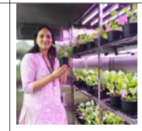

Section Collection Information
Dear Colleagues
As byproducts of aerobic metabolism, plants continually create a number of reactive oxygen species (ROS),which may be abbreviated as ROS. The production of reactive oxygen species (ROS) in plants is a normal
part of the metabolism of chloroplasts, mitochondria, and peroxisomes. ROS generation is also an occurrence that occurs alongside regular physiological processes, such as the growth of pollen tubes, the loosening of cell walls during the expansion of cells, the creation of plant fibers, the lignification of
organs, and the maturation of fruit. Depending on the characteristics of the ROS species, some of them can be extremely hazardous yet are quickly detoxified by a variety of cellular processes, both enzymatic and nonenzymatic. When plants are subjected to abiotic stress, they have an abundance of defence mechanisms at their disposal to combat the increased levels of reactive oxygen species (ROS). However, in other situations, plants appear to purposefully generate ROS as signalling molecules to control a variety of processes, such as defence against pathogens, programmed cell death, and stomatal behavior. The role of ROS in abiotic stress in plants, and propose that different abiotic stresses, such as drought, heat, salinity and high light, result in
different ROS signatures that determine the specificity of the acclimation response and help tailor it to the exact stress the plant encounters.
The main objective of this collection is to address the role of ROS in the acclimation of plants to stress combination as well as the role of ROS in mediating rapid systemic signaling during abiotic stress. Considering
its impact on the plant and crop development, the goal of the section is to publish research articles/reviews/new methods in the mechanisms of ROS generation and removal in plants during development and under biotic and
abiotic stress conditions. This section will also consider to gather new insights into the complexity and roles that ROS plays in plants and its detoxification through genetic analysis and signaling transduction pathways.
We look forward to receiving your contributions.
Dr. Sowbiya Muneer
Section Editor

